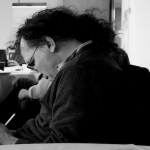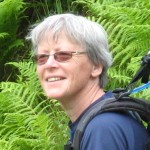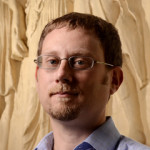Hestia Phase 2
The original Hestia project (September 2008 – July 2010) produced two innovative outcomes: the understanding of geographic space in Herodotus’s Histories in terms of connections between places and peoples rather than as points on a map; and the development and use of web technologies for visualising and thinking about a narrative. Hestia2 (July 2013 – June 2014) takes this experimental approach to analysing the geography of a written text and: (1) explores 4 key issues regarding big data in the humanities; and (2) consolidates the technological development in an innovative suite of tools for reading Herodotus’s Histories.
1. Big data in the humanities: 4 key issues
With the digital medium rapidly transforming the ways in which information is viewed and processed, data visualisation is one of the key challenges to academic and non-academic groups alike. Cultural heritage groups, government agencies and firms working in the digital economy, all have to deal with the problem of presenting big data in ways that make sense to their users but that do not reduce the complexity of the data or give a misleading picture. Hestia2 uses the key intellectual outcome of the original project—the analysis of spatial relations embedded in literary texts—to discuss humanistic approaches to data visualisation which, by virtue of being based on real content that is complex and messy, can help contribute to this debate. In a four-part seminar series, Hestia2 considers:
- network analysis techniques, methods and models used for data exploration – hosted by the Archaeological Computing Research Group, Southampton;
- digital visualisations of data, especially complex literary texts – hosted by the Stanford Center for Spatial and Textual Analysis;
- the role of GIS in mapping texts – hosted by the Department of Geography, Birmingham;
- the extent to which digital technologies help non-academics access and comprehend research – hosted by the Institute of Educational Technology, The Open University.
Key discussion points and findings from the seminar presentations have been documented on the blog.
The Seminar Leaders
 Tom Brughmans is a Postdoctoral researcher in the Department of Computer and Information Science at the University of Konstanz. His work explores the potential of network science for archaeology, such as in understanding tableware distribution in the Roman East. As a member of the HERA CARIB project he performs visibility analyses for Caribbean archaeology. (For more information, see Tom’s research blog).
Tom Brughmans is a Postdoctoral researcher in the Department of Computer and Information Science at the University of Konstanz. His work explores the potential of network science for archaeology, such as in understanding tableware distribution in the Roman East. As a member of the HERA CARIB project he performs visibility analyses for Caribbean archaeology. (For more information, see Tom’s research blog).
 Nicole Coleman is co-founder and co-director of Stanford’s Humanities+Design group and co-investigator of Mapping the Republic of Letters. Her work experiments with the design of data models and interactive graphical interfaces that allow for uncertainty, ambiguity, and nuance in data-driven research in the humanities.
Nicole Coleman is co-founder and co-director of Stanford’s Humanities+Design group and co-investigator of Mapping the Republic of Letters. Her work experiments with the design of data models and interactive graphical interfaces that allow for uncertainty, ambiguity, and nuance in data-driven research in the humanities.
 Phil Jones is a cultural geographer based at the University of Birmingham. He has a particular interest in research methods and policy debates on place and belonging. His work considers the role of qualitative GIS, mobile interviewing and arts-based approaches to mapping texts.
Phil Jones is a cultural geographer based at the University of Birmingham. He has a particular interest in research methods and policy debates on place and belonging. His work considers the role of qualitative GIS, mobile interviewing and arts-based approaches to mapping texts.
 Tony Hirst lectures for the Department of Communication and Systems at The Open University. As an open data advocate and self-proclaimed mashup artist, he is interested in how to find stories in data using freely available web tools and the use of visualisation to make sense of complex data sets. (See Tony’s blog for debates and reflections on open data and technologies).
Tony Hirst lectures for the Department of Communication and Systems at The Open University. As an open data advocate and self-proclaimed mashup artist, he is interested in how to find stories in data using freely available web tools and the use of visualisation to make sense of complex data sets. (See Tony’s blog for debates and reflections on open data and technologies).
2. Consolidating the technology: HestiaVis and the OpenLearn Herodotus
To promote wider engagement among researchers, students and general enthusiasts with the original project’s re-imagining of the geography of Herodotus’s Histories, Hestia2 consolidates its technological innovations in two ways.
First, building on a post-Hestia project called Google Ancient Places (itself inspired by Hestia), we have developed an intuitive user interface for reading text and maps alongside each other. This platform, called HestiaVis, allows users to explore the Histories in three ways. The Summary View gives you a big-picture perspective on what places occur in the book as a whole and where they appear in the narrative structure, so that you can grasp the total distribution of place references at a glance. The Reading View offers an interface for reading the text, including a narrative timeline and a map of recently-referenced places, so that you can move through the narrative and see locations appearing and ‘fading from memory’. The Place Detail view provides deeper information about a particular geographic location, including network maps of related places based on their reference together in the narrative (i.e. their textual, not geographic, proximity) and links out to data provided by other projects, so that you can find out more about the places you are interested in from other online resources.
Second, we have worked with The Open University’s OpenLearn Unit to produce free and open educational resources that make use of our technologies. You can find out more about these materials by going to the OpenLearn site or by clicking on the button “Open Learn” below. Why not try it out for yourselves and take up the challenge of Herodotus’s Histories to go and pursue your own enquiry.
The Hestia2 Developers
 Kate Byrne is a research fellow in the School of Informatics at Edinburgh University, specialising in natural language processing. She has worked on related projects, adapting the Edinburgh Geoparser for classical works, so that place names mentioned in the text can be recognised and given a spatial location. For Hestia, she has adapted the material to mesh with the GapVis tools previously created.
Kate Byrne is a research fellow in the School of Informatics at Edinburgh University, specialising in natural language processing. She has worked on related projects, adapting the Edinburgh Geoparser for classical works, so that place names mentioned in the text can be recognised and given a spatial location. For Hestia, she has adapted the material to mesh with the GapVis tools previously created.
 Eric Kansa directs Open Context, a data publishing venue for archaeology. His research interests explore web architecture, service design and policy issues relating to intellectual property. In June 2013, Eric was honoured, along with 12 other researchers, by the White House as a “Champion of Change” in promoting open science. Eric has adapted the GapVis platform for ensuring robustness, usability and functionality.
Eric Kansa directs Open Context, a data publishing venue for archaeology. His research interests explore web architecture, service design and policy issues relating to intellectual property. In June 2013, Eric was honoured, along with 12 other researchers, by the White House as a “Champion of Change” in promoting open science. Eric has adapted the GapVis platform for ensuring robustness, usability and functionality.
 Adam Rabinowitz is Assistant Professor in the Department of Classics at the University of Texas at Austin and works on exploring ancient social relations in the archaeological record. With a keen interest on using digital tools to visualise information about the Classical past, Adam has created GeoDia, an interactive spatial timeline of Mediterranean archaeology. Adam has been trialling Hestia’s resources in his undergraduate classes.
Adam Rabinowitz is Assistant Professor in the Department of Classics at the University of Texas at Austin and works on exploring ancient social relations in the archaeological record. With a keen interest on using digital tools to visualise information about the Classical past, Adam has created GeoDia, an interactive spatial timeline of Mediterranean archaeology. Adam has been trialling Hestia’s resources in his undergraduate classes.
Beverley Daley-Yates works as a freelance consultant to develop online learning resources. She has been involved in several projects for OpenLearn, some based on BBC TV productions, in collaboration with academics from the Classical Studies, Science, Modern Languages and Social Science Faculties. Beverley helped create the OpenLearn Herodotus materials.
Enrico Daga is Project Officer in Linked Data at The Open University’s Knowledge Media Institute. His main duty is the maintenance and evolution of http://data.open.ac.uk, while doing a PhD on linked data integration, maintenance and reuse. Enrico helped developed the new HestiaVis platform.









You must be logged in to post a comment.